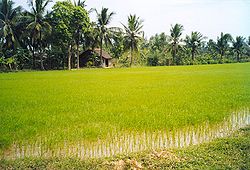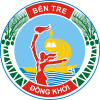Bến Tre province
Bến Tre
Kiến Hòa | |
|---|---|
| Bến Tre province | |
 Bến Tre countryside around Cái Mơn | |
| Nickname: Land of Coconuts | |
 Location of Bến Tre within Vietnam | |
 | |
| Coordinates: 10°10′N 106°30′E / 10.167°N 106.500°E | |
| Country | |
| Region | Mekong Delta |
| Provincial capital | Bến Tre |
| Government | |
| • Body | Bến Tre provincial Party Committee |
| • People's Council Chair | Hồ Thị Hoàng Yến (Communist Party of Vietnam) |
| • People's Committee Chair | Trần Ngọc Tam |
| Area | |
| • Total | 2,379.70 km2 (918.81 sq mi) |
| Population (2023) | |
| • Total | 1,799,328 |
| • Density | 760/km2 (2,000/sq mi) |
| Demonym | People of Bến Tre |
| Demographics | |
| • Ethnicities | Vietnamese, Khmer, Hoa, Chăm |
| GDP[2] | |
| • Total | VND 41.851 trillion US$ 1.818 billion |
| Time zone | UTC+7 (ICT) |
| Postal code | 86xxx |
| Area codes | 75 (until 16 July 2017) 275 (from 17 June 2017) |
| ISO 3166 code | VN-50 |
| HDI (2020) | (49th) |
| Website | www |
Bến Tre is a province of Vietnam. It is one of the country's southern provinces, and is situated in the Mekong Delta. It is also famous for its coconuts and the Coconut Religion nationwide. Disconnected from the mainland, the province lies mainly on 2 river islands. It has land borders only with Vĩnh Long Province, which occupies the western tip of the southern river island.
Etymology
[edit]The origin of the province’s name is still unclear as it was first inhabited by the Khmer people, though some speculated it may have been called Kompong Russei. Its original name was then later altered by incoming waves of immigration and settlement by ethnic Vietnamese into Bến Tre.[4] In Vietnamese, “Bến Tre” literally means “bamboo port”, which is quite inaccurate considering it is regionally famous for its Coconuts.
History
[edit]In what has been called "the start of the Vietnam War", in January and February 1960, the Việt Cộng attacked and took temporary control of several districts in Bến Tre, then known as Kiến Hòa.[5] The Việt Cộng set up "people's committees", and confiscated land from landlords and redistributed it to poor farmers. One of the leaders of the uprising was Madame Nguyễn Thị Định, who led the all-female "Long Hair Army".
Although the South Vietnamese army (ARVN) recaptured the villages, uprisings spread to many other areas of South Vietnam. The uprisings were spontaneous rather than planned.[6]
Administration
[edit]Bến Tre is subdivided into 9 district-level subdivisions. The eight districts are Ba Tri, Bình Đại, Châu Thành, Chợ Lách, Giồng Trôm, Mỏ Cày Bắc, Mỏ Cày Nam, and Thạnh Phú. There is also one provincial city of Bến Tre (capital). They are further subdivided into 7 commune-level towns (or townlets), 147 communes, and 10 wards. To view the list of subdivisions, see List of communes in Bến Tre province.
Geography
[edit]Geographically, Bến Tre is wedged between the two main branches of the Tiền Giang River, which is itself one of the two main distributary of the Mekong. The province's northern boundary is formed by the Tiền Giang's main course, while the province's southern boundary is formed by the Tiền Giang's largest branch (which breaks away from the Tiền Giang just upriver from Bến Tre province). Between the Tiền Giang and its main branch are two smaller branches, passing through the middle of Bến Tre. As a result, this province may be considered having 2 main river islands and has land borders only with Vĩnh Long Province on its western tip.
The entire province is criss-crossed with a network of smaller rivers and canals. The extensive irrigation that this provides makes Bến Tre a major producer of rice, but also means that the area is prone to flooding. The Climate Change Research Institute at Cần Thơ University, in studying the possible consequences of climate change, has predicted that 51% of Bến Tre province can be expected to be flooded if sea levels rise by 1 meter.[7] Bến Tre province is, on average, only 1.25 meters (4 ft 1 in) above sea level.
This section is empty. You can help by adding to it. (November 2024) |
Education
[edit]This section is empty. You can help by adding to it. (November 2024) |
Economy
[edit]This section is empty. You can help by adding to it. (November 2024) |
Infrastructure
[edit]This section is empty. You can help by adding to it. (November 2024) |
Culture
[edit]This section is empty. You can help by adding to it. (November 2024) |
This section is empty. You can help by adding to it. (November 2024) |
Transportation
[edit]Construction on the Rạch Miễu Bridge, which links Bến Tre to neighboring Tiền Giang province to its north, was started in 2002. The bridge was finished and opened for traffic on 19 January 2009. Before that time, Bến Tre was only accessible to automobiles via ferry.
Notable people
[edit]- Nguyễn Phương Khánh, Vietnamese beauty pageant titleholder (born 1995 [1994])
Gallery
[edit]-
Trung học Phổ thông Chuyên Bến Tre
-
Công viên Trúc Giang
-
Kênh Chợ Lách
-
Cồn Phụng Hotel
-
Tân Thạch Communal House
-
Memorial stele
Trương Vĩnh Ký -
Reserves of Đạo Dừa
at Con Phung -
Congregation Church
Christ the King -
Church of Our Lady
Roman -
Tourist boats dock at Con Phung wharf on Tiền River
-
The coconut garden is green thanks to alluvium
-
Coconut is a large-scale and popular crop grown in bến Tre
References
[edit]- ^ Biểu số 4.6: Hiện trạng sử dụng đất vùng Đồng Bằng Sông Cửu Long năm 2022 [Table 4.6: Current land use status in the Mekong Delta in 2022] (PDF) (Decision 3048/QĐ-BTNMT) (in Vietnamese). Ministry of Natural Resources and Environment (Vietnam). 18 October 2023. – the data in the report are in hectares, rounded to integers
- ^ "Tình hình kinh tế, xã hội Bến Tre năm 2018". Cổng thông tin điện tử tỉnh Bến Tre. Retrieved 10 May 2020.
- ^ "Human Development Index by province(*) by Cities, provincies and Year". General Statistics Office of Vietnam. Retrieved September 28, 2024.
- ^ Kiernan, Ben (2017). Việt Nam: A history from earliest times to the present. Oxford University Press. p. 10.
- ^ Pringle, James, "Meanwhile: The quiet town where the Vietnam War began", The New York Times, 223 March 2004
- ^ Asselin, Pierre (2013). Hanoi's Road to the Vietnam War, 1954–1965. Berkeley: University of California Press. p. 73.
- ^ "Mekong Delta: more flood and drought" Archived May 5, 2010, at the Wayback Machine. VietnamNet Bridge. 19 March 2009.
External links
[edit]- Bến Tre website (in English)
- Bến Tre website Archived 2014-11-03 at the Wayback Machine (in Vietnamese)
- Bến Tre province profile
- Website Thành phố Bến Tre - Ben Tre City














